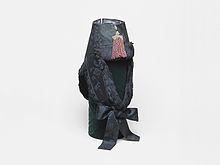Nambawi
| Korea-Seoul-Gyeongbokgung-Palace Guard with a Nambawi under a Jurip (주립) (Winter 2008) | |
|---|---|
| Korean alphabet : | 남바위 · 풍뎅이 · 난 이 · 이엄 |
| Hanja : | - · - · 暖 耳 · 耳 掩 |
| Revised Romanization : | nambawi pungdengi nani ieom |
| McCune-Reischauer : | nambawi p'ungdengi nani iŏm |
The Nambawi is a traditional Korean headgear for men and women that was worn as protection against the cold in the early Joseon Period (1392–1897). Other names are Pungdengi and Nani , or Ieom ("covers the ears"). Originally, they were only used by members of the upper class as an everyday winter hat. However, it spread to the general bourgeoisie later in the epoch. They were usually worn by older and middle-aged women, as well as the officers under the samo (사모, official hat).

The Nambawi has no hat lid, it is open at the top. This differs significantly from other winter headgear , including the similar Korean forms such as Ayam and Jobawi . However, it completely protects the front and back of the head, ears and cheeks. The edge of the hat is trimmed with 4 to 7 centimeters wide strips of fur, mostly marten fur . The Nambawi has two ear flaps and a long flap that covers the neck. It is held under the chin with two silk ribbons. The outer fabric usually consists of a type of silk called Dan (단, 緞), but sometimes wool or cotton. Flannel was used for the inner lining or, occasionally, warmer wool.
The common color for the outer fabric of the men's hat was black, while for the inside, black, green or red was used. However, there were also more noticeable exterior colors, from dark blue to purple, maroon, light purple to light green. A yellow colored fabric was also used for the inside. The fur around it was usually black, dark brown, or dark blue, and the tassels were pink or light pink. The Nambawi for women were colorful and luxurious with geumbak (a gold leaf decoration ) and adorned with cranes , butterflies, chrysanthemums , a phoenix or other good luck motifs.
Web links
- [4] www.researchgate.net: Hanbok, a traditional Korean costume . February 22, 2016 (English). Retrieved March 11, 2017
literature
- Yu Hui-gyeong (유희경, 柳喜卿): Research on Korean Costume (한국 복식사 연구) . Ewha Women's University (Korean).
Individual evidence
- ↑ Archived copy ( memento of the original from April 22, 2013 on WebCite ) Info: The archive link was inserted automatically and has not yet been checked. Please check the original and archive link according to the instructions and then remove this notice. Hanboks (traditional clothings) ; Headgear and Accessories Worn Together with Hanbok . Korea Tourism Organization (eds.) (English). Retrieved March 11, 2017.
- ↑ a b c Archived copy ( memento of the original from March 25, 2012 in the Internet Archive ) Info: The archive link was inserted automatically and has not yet been checked. Please check the original and archive link according to the instructions and then remove this notice. . 남바위 . Empas (eds.) / EncyKorea (Korean). Retrieved March 12, 2017.
- ↑ [1] 남바위 . Doosan Encyclopedia (Ed.) (Korean). Retrieved March 12, 2017.
- ↑ [2] www.culturecontent.com: Traditional women's headgear: Nambawi . (Korean). Retrieved March 12, 2017.
- ^ [3] books.google.de, National Research Institute of Cultural Heritage: Gat, Traditional Headgear in Korea . P. 151 (English). Retrieved March 12, 2017.
